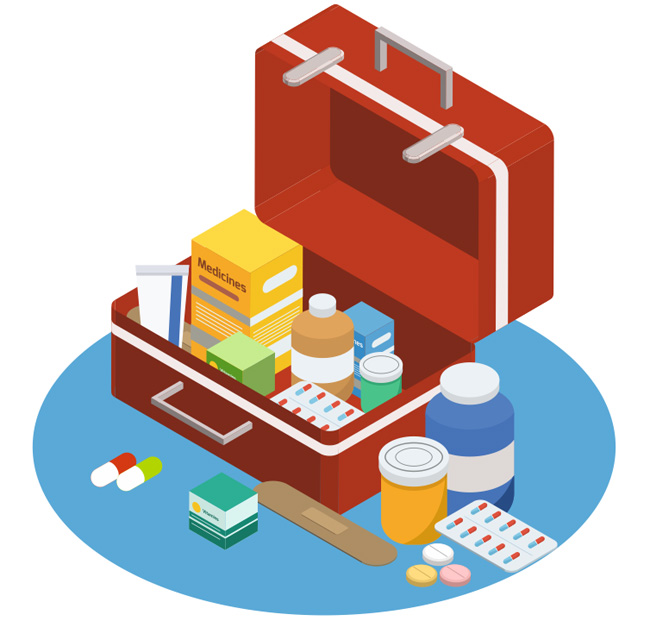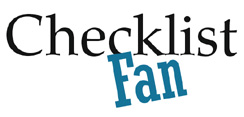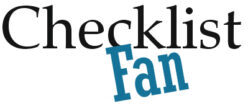
A travel health kit is designed specifically for the needs of travelers. It ensures that you are quickly and easily supplied with medicines and materials for minor emergencies and minor health problems. This is even more important the further away the nearest pharmacy is.
A checklist makes it easy to think of everything you need to do – step by step, without forgetting anything. In this article, you’ll find a clear and practical overview to help you assemble your travel health kit quickly and efficiently. Let’s get started – for a relaxed and carefree trip!
Suggested use of the checklist
- To get an overview of the contents of a travel health kit, I recommend that you go through the checklist in its entirety. You can skip items that don’t apply to your destination. Check to see if you have everything you need for your travel health kit or if you need to buy anything else. Also check that the products you already have are not past their expiration date.
- The checklist is numbered sequentially. If you are pressed for time and cannot complete the checklist all at once, write down the last number and continue later.
Checklist:
Travel health kit
| General |
| 1. Current medications and a list of medications with dosage information – Make sure all regularly taken medications are easily accessible with clear dosage instructions to avoid errors. A written list can help you keep track. |
| 2. Allergy remedies – Carry an antihistamine or other allergy medicine to respond quickly to allergic reactions such as sneezing, itching, or rashes. |
| For the skin |
| 3. Facial sunscreen – Use a facial sunscreen with a high sun protection filter (SPF) to protect sensitive skin from ultraviolet (UV) rays and premature aging. |
| 4. Body sunscreen – Use a water-resistant sunscreen to protect body skin from sunburn and long-term UV damage. |
| 5. Children’s Sunscreen – Children need an extra high SPF sunscreen because of their sensitive skin. Use gentle, kid-friendly sunscreens without harsh ingredients. |
| 6. After sun care – After sun exposure, treat skin with hydrating and soothing products to reduce redness and dryness. |
| For the stomach and intestines |
| 7. Anti-diarrheal medication – Have medications on hand to reduce fluid loss and restore intestinal balance. |
| 8. Electrolytes for fluid loss – Electrolyte powders or solutions help replenish fluids and minerals lost through diarrhea or vomiting. |
| 9. Constipation relief – A mild laxative may help relieve constipation and normalize digestion. |
| 10. Medication for upset stomach (gas, cramps, nausea) – Keep medicines to relieve bloating, stomach cramps, and nausea handy for quick relief from digestive problems. |
| 11. Heartburn relief – Carry antacids or other medicines to quickly neutralize stomach acid. |
| For the eyes |
| 12. Dry eye drops – Use moisturizing eye drops to soothe dry or irritated eyes, especially in dry air environments. |
| 13. Daily contact lenses – Have an adequate supply of daily disposable contact lenses. |
| 14. Contact lens solutions and case – Use cleaning and storage solutions along with appropriate cases for your contact lenses. |
| For minor injuries |
| 15. Wound healing ointment (antiseptic if necessary) – Use an ointment to help minor wounds heal and prevent infection. |
| 16. Wound and skin disinfectant spray – Disinfect minor wounds immediately to reduce the risk of infection. |
| 17. Cooling gel – Provides cooling relief for insect bites, sunburn or minor skin irritations. |
| 18. Ointment for bruises/sprains/strains – Use anti-inflammatory ointments to reduce swelling and pain from bruises or sprains. |
| 19. Bandages (blister and waterproof) – Keep a variety of bandages handy to protect blisters, minor cuts, and wounds from dirt and moisture. |
| 20. Sterile and waterproof dressings – Sterile dressings help cover larger wounds to keep them clean and prevent infection. |
| 21. Splinter tweezers – A fine-tip tweezer is ideal for safely removing splinters or small foreign objects. |
| Head/tooth/body aches, fever, cold symptoms |
| 22. Fever-reducing and anti-inflammatory medicines – Keep medicines such as ibuprofen or acetaminophen for fever and inflammation. |
| 23. Pain relievers – Use pain relievers for mild to moderate pain, such as headache, toothache, or body aches. |
| 24. Nasal spray – A decongestant nasal spray helps relieve nasal breathing during colds or allergies. |
| 25. Throat lozenges – Throat lozenges relieve pain and moisturize the throat during irritation or inflammation. |
| 26. Cough suppressant – A cough suppressant can soothe dry coughs and prevent nighttime coughing fits. |
| Insect protection |
| 27. Insect repellent spray – Use an insect repellent spray to prevent bites from mosquitoes, ticks, fleas, or horseflies. |
| 28. Electronic bite healer – A device that uses heat or electrical impulses to reduce itching and swelling after insect bites. |
| 29. Insect bite gel – Relieves itching, swelling and irritation caused by insect bites. |
| Practical items |
| 30. Motion sickness medication – Use anti-nausea medication to quickly treat motion sickness on airplanes or boats. |
| 31. Disinfectant wipes – Keep disinfectant wipes handy to clean hands or surfaces while traveling. |
| 32. Scissors (not allowed in carry-on for flights) – Scissors are useful for cutting bandages or dressings, but should be packed in checked luggage. |
| 33. Vitamin and mineral supplements – Supplements can help correct deficiencies while traveling or meet specific dietary needs. |
| 34. Disposable gloves – Disposable gloves are essential when treating wounds or illnesses to prevent infection. |
| 35. Thermometer (especially in malaria areas) – A reliable thermometer helps detect fever early. |
| 36. Compression socks for long flights – Compression socks improve circulation and reduce the risk of thrombosis on long flights. |
| 37. Antifungal cream for athlete’s foot – Keep antifungal cream handy to treat the first signs of athlete’s foot. |
| 38. Cold sore cream – An antiviral cream helps relieve the symptoms of cold sores and speeds the healing process. |
| 39. Heat patches for muscle relaxation – Heat patches can help relieve muscle tension and pain, especially in the back. |
| 40. Cold packs for bruises and strains – Cold packs reduce swelling and relieve pain from bruises and strains. |
| 41. Ear drops (especially for diving trips) – Ear drops can help remove water from the ears and prevent infections, especially after diving. |
| 42. Temporary dental filling – A temporary dental filling is useful for quick fixes to dental problems while traveling. |
| 43. Emergency thermal blanket – A thermal blanket keeps the body warm and prevents hypothermia. |
| 44. Tranquilizers – Sedatives can help reduce stress and anxiety, for example during a flight. |
| 45. Sleep aids – Mild sleep aids or herbal supplements can help with sleep problems such as jet lag. |
| Miscellaneous |
| 46. Follow airline regulations for carrying medications, controlled substances, and infusion equipment. |
| 47. Obtain a doctor’s prescription and instructions for medications, including chemical compositions, to carry important medications in your carry-on bag. |
| 48. Bring your immunization record. |
_________
That’s all you need for a travel health kit. If it’s been a while since your first aid course and you need a refresher, check out the 7 steps of first aid. I hope the checklist was helpful and I would be happy if you visit ChecklistFan.com again.
Your ChecklistFan

More checklists
All checklists on ChecklistFan.com
Note: All information is provided to the best of my knowledge, but I assume no liability and make no claim to completeness or accuracy. I have translated the checklist from my German website ChecklistFan.de. Please note that it describes conditions and requirements specific to Germany, which may differ from your local area or country. Adjustments may be necessary to reflect your local conditions or regulations. Some of the resources I used to create the checklist include: Cleveland Clinic, CDC, Johns Hopkins Medicine. If you have any suggestions for improving the checklist, you can leave a comment or write to me: reiko@checklistfan.com.

